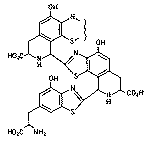|
Carotenoids – Vitamin A PrecursorsCarotenoids form a group of provitamin A precursors and naturally occurring compounds that give the deep yellow, orange, and red colors to fruits and vegetables such as carrots, tomatoes and apricots. They are also found in dark green vegetables such as spinach.
Carotenoid Structure
The major carotenoids are alpha-carotene, beta carotene, lutein, lycopene, zeaxanthin, and cryptoxanthin. Beta-carotene is the most common of these. The human body can convert alpha-carotene, beta-carotene, and beta cryptoxanthin to retinol. Although carotenoids are not considered essential nutrients, they do have many biological functions other than the conversion of some of them to vitamin A. They have roles as antioxidants, bolstering the immune system, enhancing vision and are thought to be instrumental in preventing some types of cancers. Impact On Vision Lutein and zeaxanthin are found in the macula of the eye which is the central portion of the retina responsible for sharp and detailed vision. Studies have shown that increased intake of lutein lowers the risk for age related macular degeneration. An intake of lutein and zeaxanthin has also been found to decrease the risk of cataracts. Impact On Cancer Human and animal studies have found that having a high intake of carotenoid rich fruits and vegetables and/or high bloods of these provitamins also usually have a lower risk for certain types of cancer. In specific: • Alpha-carotene, beta-carotene, lutein, and zeaxanthin may lower the risk of breast cancer. • Cryptoxanthin protects against skin cancer and may protect women from cervical cancer. • Lutein, alpha-carotene, lycopene, and zeaxanthin may lower the risk of lung cancer. • Lycopene may lower the risk of prostate cancer in men. Studies generally show that the effects from these provitamins are stronger when ingested in the diet than in supplementation alone. Dietary Sources Alpha-carotene, beta-carotene, and cryptoxanthin are generally found in orange and yellow fruits and vegetables. Beta-carotene is found in carrots, pumpkins, winter squash, sweet potatoes, cantaloupes, apricots and mangos. Lycopene can be found in tomatoes, tomato products, pink grapefruit, watermelon, and guava. Lutein and zeaxanthin are present in leafy green vegetables, red peppers and pumpkins. Cryptoxanthin is found in oranges, nectarines, tangerines, mangos and papaya.
Although we may often like to eat certain vegetables raw such as carrots and spinach in salads, it has been shown that a few minutes of cooking such as with steamed vegetables breaks down the bonds in food and makes it easier for carotenoids to be released and absorbed by the body.
For other information on nutrition some great references are: • Nutrition – Fourth Edition by Paul Insel, Don Ross, Kimberley McMahon, and Melissa Bernstein
Vitamins
|







